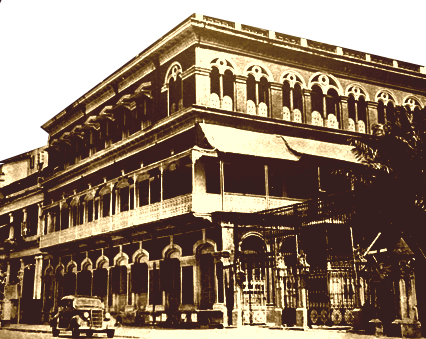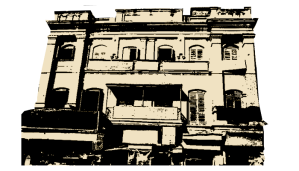
বঙ্গীয় জাতীয় মহাবিদ্বালয়, কলকাতা, ১৯০৬
The urge for setting up an institution that would impart education along nationalist lines was strongly felt by the early 20th century intelligentsia when Bengal was torn apart by the Curzon administration to reinforce British dominance politically and culturally. Backed by the Universities Act of 1904 the Calcutta University Senate and Syndicate were reshuffled co-opting more white members to ensure sufficient government control in policy making. The government also decided to disaffiliate certain new private colleges, which were looked upon by them as hotbeds of nationalist agitation. These offensive measures of the then Government frustrated the sentiment of educated middle class and incited a move for alternative systems of education.
A protest meeting was organized on November 5, 1905 under the auspices of the Dawn Society of Satish Chandra Mukherjee. The meeting was addressed by Rabindranath, Satish Chandra Mukherjee and Hirendranath Datta urging the students to severe all connections with the Government controlled university.
On November 9, a mass meeting was held at the Field and Academy Club. In that meeting it was decided that if it is the aim of the British government to destroy the freedom movement and if they exert such tyranny and oppression on young students, the people of the country would establish a national university. Subodh Chandra Mullick pledged a donation of one lakh Rupees.

Many others came forward to donate generously for the cause, including some native kings and princes and other like-minded dignitaries like Brojendra Kishore Roy Choudhury, Maharaja Suryya Kanto Acharya Choudhury. Leaders like Chitta Ranjan Das, Bipin Pal, Ramendrasundar Trivedi began to address Subodh Chandra as the ‘Raja’. Rabindranath congratulated the endeavour saying that after a long time, the Bengalis received a gift. Subodh Chandra’s contribution to the nationalist education movement seems however far greater than the sum he donated. He committed to establishing nationalist university even before its idea mooted, played a critical role in designing the institution incognito, and remained a part of its history ever since.
To challenge the British rule over education a huge meeting was sponsored by the Landholders’ Society at Park Street on November 16, 1905, attended by around 1500 delegates together with Rabindranath Tagore, Aurobindo Ghosh, Raja Subodh Chandra Mullick and Brajendra Kishore Roychowdhury.


On 11th March, 1906, the National Council of Education, Bengal, or Jatiyo Siksha Parishad was founded to provide a platform for ‘a system of education – literary, scientific & technical – on national lines & under national control’ following a declaration made in a meeting held in Bengal Landholders’ Association. With Dr. Rashbehari Ghosh as the president, plans were afoot to establish a national college & school in Calcutta. In a public meeting, held on the 14th August, 1906 at the Town Hall, the Bengal National College & School was inaugurated.
The institution started to work from 15th August, 1906 in a rented house on 191/1, Bowbazar Street with Sri Aurobindo Ghosh as Principal and Sri Satish Chandra Mukherjee as an Hony. Superintendent. The institution had four departments – Literary, Scientific, Technical & Commercial. Scholars like Sakhram Ganesh Deuskar, Radhakumud Mukhopadhyay, Binay Sarkar, Khirode Prasad Vidyabinode voluntarily agreed to serve this new university. Rabindranath agreed to lecture on literature, Ananda Coomaraswamy on Oriental Art, Sir Gurudas Bandyopadhyay on Mathematics, Hirendranath Dutta on Upanishads.
The same time, another nationalist body, the Society for Promotion of Technical Education in Bengal, was set up with contending ideas by Taroknath Palit under patronage of Maharaja Manindra Chandra Nandy, Bhupendra Nath Bose, Nilratan Sircar and others who laid stress on the technical education alone. Under its management the Bengal Technical Institute was establish on July 25, 1906 with the objectives of spreading technical education among the masses.
In 1910 the two societies merged. The two colleges were virtually the faculties of “Humanities and Science” and of “Technology” of the National Council of Education. Several national schools also were founded in this period at different places in Bengal. Even after the merger, it was painfully observed that ‘not a student cared to come for a literary and scientific instructions along national lines’ See S. N. Sen

Sri Aurobindo clinically analyzed the conditions that failed the nationalist education movement originated in 1905. Some of the major causes of its collapse he pointed out were given here in a nutshell. To the majority of Council members, he thought, Nationalist Education was merely an interesting academic experiment, and regarded it merely as the ladder by which they climb and busy trying to kick it down. To others the only valuable part of it was the technical instruction given in its workshops. They really were shutting off the steam, yet expect the locomotive to go on. He also stressed on the unrealistic approach of its planning and designing. Curriculum of the Council is extraordinarily elaborate and expensive, as it was on the vicious Western system of driving many subjects at a time, serving as ‘a brain-killing and life-shortening machine’. See Sri Aurobindo –
The institution had many ups and downs in its struggling history before being reincarnated in the form of the present-day Jadavpur University.
The photograph featured at the top shows the house of Raja Subodh Chandra Mullick, at 12 Wellington Square. This was where the idea of national university in nationalist line was seeded and grown into Bengal National College with the initiative and care of Subodh Chandra and Aurobindo who stayed with him as his honourable guest. When he served as the Principal, Aurobindo would go from the Bengal National College to the evening gathering at this house to exchange views and plans in nationalist line.


College of Engineering & Technology and Jadavpur University are descendants of this Institution
LikeLike
Sorry dear Shri Ray for responding so late. To my understanding, JU is hierarchically related to BNC, but not its wing the College of Engineering & Technology, which has its source in another nationalist institution, Bengal Technical Institute. My thanks and wishes
LikeLike